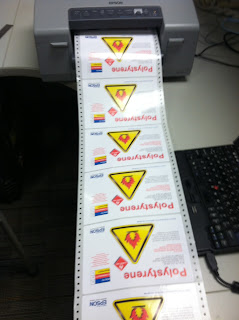On October 25th and 26th, Marc
Jorrens, Co-Founder and President of Outbound Software invited me to
participate in their first annual user conference. At the conference, I had the opportunity to
learn more about Outbound and their customers.
Just recently, Outbound decided to integrate the TM-C3400 into their
software; and wanted me to demonstrate and talk about print on-demand color
tickets and wristbands.
According to Marc, “I saw an opportunity to differentiate
our product by enabling customers to print on-demand; and eliminate preprinted
tickets. Since completing the
integration, I have found the small Epson printer produces great color tickets
that are instant waterfast and very durable.
The pigment-based ink is great”.
During the Outbound event, I spoke to customers with 4
different types of requirements for print on-demand color tickets. First; promote special events. Many types of attractions have special events;
both large and small. Producing tickets
positions the event in the minds of the attendees as “special” enabling the
tickets to act as mementos. Adding
images, graphics, logo’s, etc. signify the importance of this special event;
creating more value.
Second, honor sponsors.
With print on-demand color tickets, attractions can honor sponsors;
making their sponsorship more valuable.
Many non-profit attractions need sponsors to cover portions of the
operating costs. Therefore, these
non-profits need to find ways to increase the value of the sponsorships offered. By using print on-demand tickets with logo’s
and recognition, the sponsor gets more value.
Third, change processes.
Print on-demand enables attractions to change selected processes. During the Outbound event, I spoke to a
controller for a military attraction.
This organization uses wristbands to track approximately 240,000 annual paid
attendees. As wristbands act as
“currency”, the organization must track the wristbands precisely. They hold an inventory of several colors of
wristbands (different color per day); take inventory at the beginning and end
of each day; and reconcile the inventory with the paid attendance. This process takes a significant amount of
time and effort. By moving to print
on-demand wristbands, they now can keep only a small amount of blank inventory
that has no value. When printed at the
point of sale, the serialized and barcoded wristbands become the entrance
ticket. Once attached to the attendee,
guards can scan the wristbands easily and quickly completing a reconciliation
process.
Fourth: replace Boca/thermal ticket printers. As the leading provider of ticket printers,
Boca has been producing basically the same thermal printers for years. By moving away from monochrome print and the
Boca printer language (Friendly Ghost Language or FGL), users have more
flexibility with their ticketing systems.
As I heard one attendee say, “Since I need to purchase new printers, why should I purchase technology from the 80’s for ticketing. I like the idea of having the capability to
produce many types of print; and not just black tickets.”
You may find my other posts on print on-demand wristbands of
interest:
Wild Rivers: http://colorlabelsondemand.blogspot.com/2012/08/slide-into-on-demand-color-wristbands.html
Save-The-Bay: http://colorlabelsondemand.blogspot.com/2011/09/new-solution-on-demand-color-wristbands.html
If you or your customers use tickets or wristbands somewhere
in the operation, consider how print on-demand color enables new procedures and
promotions; saving attractions money and enabling greater revenues.
Guy Mikel















